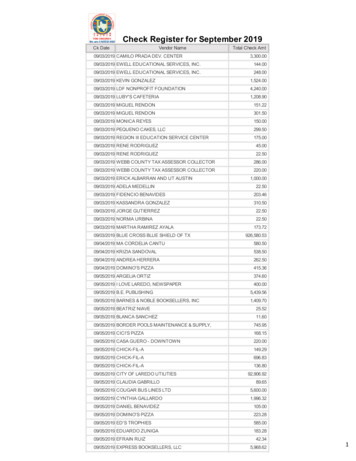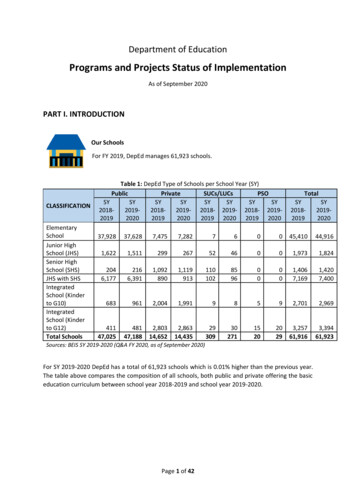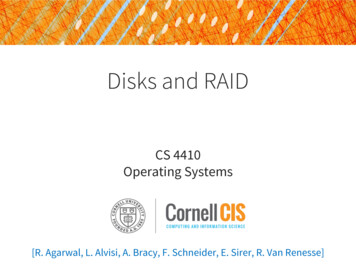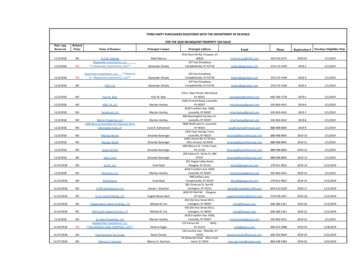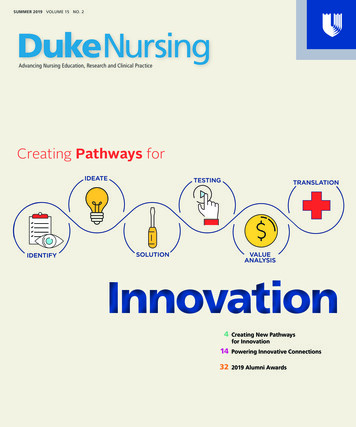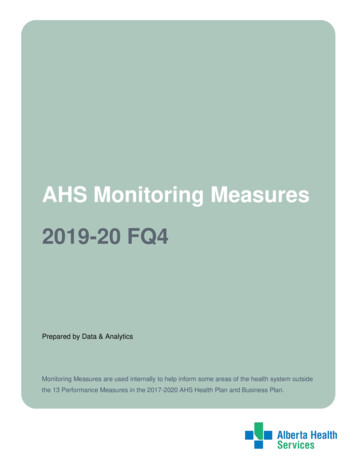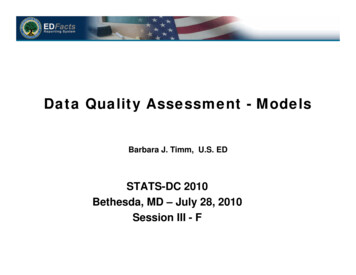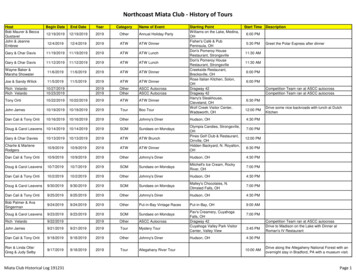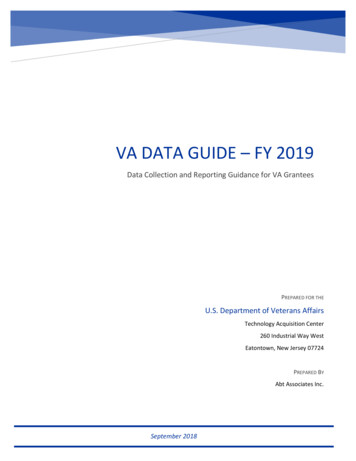
Transcription
VA DATA GUIDE – FY 2019Data Collection and Reporting Guidance for VA GranteesPREPARED FOR THEU.S. Department of Veterans AffairsTechnology Acquisition Center260 Industrial Way WestEatontown, New Jersey 07724PREPARED BYAbt Associates Inc.September 2018
ContentsSummary of VA Data Guide Revisions since FY 2018. 1VA Programs & HMIS Participation . 1I. Data Guide Introduction and Overview . 3Other Training Materials for Grantees . 3SSVF Data Collection & Reporting 101 . 3Reporting Data through VA’s Repository . 4HMIS: Beyond Data Collection . 4SSVF HMIS Administrator and Vendor Training . 4Developing a Comprehensive Data Quality Plan . 4II. HMIS Participation Planning . 5Overview . 5Requirements. 5Considerations in HMIS Planning . 5Other Grantees Operating in the Same CoC . 5Percentage of Participants in a CoC . 6Location of Service Providers . 6Participation Fees. 6HMIS Software . 6HMIS Implementation Capacity . 7Entering Data into One HMIS and Exporting Data to Another . 7Questions to Consider. 7III. HMIS Project Descriptor Data Elements . 92.1 Organization Identifiers . 92.2 Project Identifiers. 92.3 Continuum of Care Code . 92.4 Project Type . 92.5 Method for Tracking Emergency Shelter Utilization. 92.6 Federal Partner Funding Sources . 102.7 Bed and Unit Inventory . 102.8 Additional Project Information . 10IV. HMIS Data Collection Instructions. 11
HMIS Universal and Program Specific Data Elements Required by Program . 11Assistance Type . 13Data Elements . 15Data Quality and Completeness Policy . 26Mandatory Data Collection . 26Social Security Numbers (SSN) . 27HMIS Data Collection for Participants with History of Domestic Violence . 27HMIS Duplicate Enrollments . 27Data Security Policy. 27Additional Security Measures for Sensitive Data. 28HMIS Privacy & Security Requirements . 28V. SSVF Reporting . 30Monthly Repository Uploads . 301)SSVF Validation Report . 30a.Validation Results. 30b.Data Quality Results . 302)SSVF Repository Monthly Reports . 31Quarterly Certification . 31VA Repository Data Upload Criteria. 32Data Upload Format. 32Data Integration Criteria . 32Required HMIS CSV v6.12 Files . 33Reading V2 Service Provided - SSVF and V3 Financial Assistance - SSVF for HMIS CSV 6.12 . 45Services.csv . 45Repository User Guide . 47Accessing the Repository . 47Creating an Account . 47Logging in to the Repository . 48Forgotten Username or Password . 49Generating an Export of HMIS Data. 49Handling More than One Export . 49Preparing CSV Data for Upload . 50Uploading Data . 51
File Validation . 52Reading the Validation Results . 53How to Tell If an Upload Is Successful . 53Repository User Account Information . 53VI. Data Quality Management. 55What is Data Quality? . 55What is a Data Quality Plan?. 55Component 1: Timeliness. 56Component 2: Completeness. 57Component 3: Accuracy . 57Component 4: Monitoring . 58Component 5: Incentives and Enforcement . 58VII. Continuum of Care Integration & Planning . 59Continuum of Care (CoC) Overview . 59Coordinated Entry Systems. 59Data Collection and Management Toolkit Materials . 60Checklist & Discussion Guide for New Grantees . 60Additional Resources for Data Quality Management, Privacy and Security. 63Sample Data Quality Plan – SSVF Grantees . 64Quality Assurance and Data Quality Policy . 64General Procedures for Quality Assurance, Evaluation & Data Quality: . 64Sample Client Notification Forms – SSVF Grantees . 68Sample 1. 68Sample 2. 69
Summary of VA Data Guide Revisions since FY 2018 Updated to HMIS information to the 2017 HMIS Data Standards version 1.3 Added Employment Status (R6) to collection requirements Clarified Veteran Status (3.7) regarding attendance at training Added information regarding SSVF’s Rapid Resolution Program Added information regarding SSVF’s Returning Home Program Updated SSVF reporting section to reflect the new data quality checks built into the DataValidation Report Removed the VA Compensated Work Therapy – Transitional Residence (CWT/TR) program fromVA’s collection requirements due to its reclassification as an institutional settingVA Programs & HMIS ParticipationA Homeless Management Information System (HMIS) is a community-based application that collects andreports on the characteristics and needs of people who are served by programs intended to prevent andend homelessness in a particular geographic area or Continuum of Care (CoC). U.S. Department ofVeterans Affairs (VA) is committed to HMIS participation by VA-funded homeless assistance providers tosupport community-based service planning and coordination for Veterans and others who are homelessand at risk of homelessnessIn June of 2010, VA released a Strategic Plan that identified thirteen major initiatives, one of which is theElimination of Veteran Homelessness. This major initiative promotes the use of robust managementsystems to monitor outcomes for individual Veterans as well as the outcomes of programs that servehomeless Veterans, and is consistent with strategic plans developed by the United States InteragencyCouncil on Homelessness (USICH) and the U.S. Department of Housing and Urban Development (HUD).As a result of this federal coordination, VA-funded Grant and Per Diem (GPD) providers, Health Care forHomeless Veterans (HCHV) Contract Emergency Residential Services providers, and Supportive Servicesfor Veteran Families (SSVF) providers have been directed by VA to participate in HMIS implementationsoperated by each CoC in which they provide services.With respect to HMIS participation by VA homeless programs other than GPD and HCHV/CERS, the VAHomeless Program Office released national guidance on August 31, 2015 that VA staff may obtain readonly access to HMIS, as long as the data is used as part of the job responsibilities of the individualobtaining access; VA staff are also permitted to enter data directly into an HMIS if a Release ofInformation (ROI) is in place and the entry contributes to the job responsibilities of the VA staff enteringthe data. In both cases, the data entered must be used to provide needed services and coordinated careto Veterans. VA’s full guidance can be viewed at: cy-q-a/.VA Data Guide – FY 2019 (published September 2018)Page 1
CoC leadership and HMIS project staff will need to consider the following when planning for HMISparticipation: Local CoC and HMIS staff should coordinate with local VA officials and VA-funded providers toinitiate HMIS participation for community-based service providers who are not yet participatingin HMIS. VA-funded projects participating in HMIS are subject to the requirements of the most recentversion of the HMIS Data Standards and 2004 HMIS Technical Notice , which define HMIS datacollection and privacy, security, data quality, and software requirements. Documentation isavailable on the HUD Exchange website ta-dictionary/). VA-funded projects participating in HMIS are subject to HMIS policies and proceduresestablished by the CoC(s) in which they operate, but they are also subject to VA requirements.For SSVF grantees, GPD Grantees and HCHV Grantees, VA requirements include the export ofclient-level data from HMIS for upload to VA’s HMIS Repository. It may be necessary to amendHMIS policies and procedures in the event that they would prevent these VA grantees fromcomplying with this requirement. VA will provide HMIS training to VA-funded projects required to participate in HMIS; topics willinclude a general HMIS overview, HMIS participation requirements, a review of the HMIS DataStandards as they apply to VA-funded projects, and forthcoming HMIS Technical Standards (tobe released by HUD), which will include minimum standards for HMIS governance, privacy,security, software, and data quality. There are costs associated with HMIS licenses, training, technical support, data storage, systemmaintenance, and HMIS administration. Given the requirement that SSVF, GPD and HCHVgrantees export and upload client-level data to the Repository at least monthly, and thatgrantees operating in multiple CoCs may also provide exported data to other HMISimplementations, HUD expects HMIS project staff and CoC leadership to assess the costsassociated with including VA-funded providers in HMIS, to document the allocation of thosecosts, and to assess any participation fees in an equitable and transparent manner. VA staff and other federal partners will work together to provide additional training materialsand technical assistance (TA) support as VA expands HMIS participation requirements.This manual is comprehensive with respect to SSVF, GPD and HCHV; information and project setupguidance for HMIS administrators about other VA programs participating in HMIS is available on theHUD Exchange website Data Standards landing page s-data-dictionary/).VA Data Guide – FY 2019 (published September 2018)Page 2
I. Data Guide Introduction and OverviewThe purpose of this document is to convey all data management requirements to VA grantees requiredto participate in HMIS while providing the necessary tools to properly meet these requirements andmanage program data. The reporting requirements in 38 CFR 62.71 have been designed to provide VAwith the information required to assess the outcomes associated with grantees’ programs. As a result ofthis, VA anticipates grantees’ programs will assist in reducing the number of Veteran families who arehomeless or at risk of homelessness.The guide is designed for use by grantees, staff, HMIS administrators, and CoC partners. The purpose ofthe guide is to provide information and instructions on all aspects of managing VA-required HMIS data.The guide is divided into the following sections:HMIS Participation Planning. This section includes a general overview of HMIS participationrequirements and guidance for grantees in decision-making about how to fulfill them.HMIS Project Descriptor Data Elements. This section provides guidance to HMIS administrators andHMIS vendors on how to complete the Project Descriptor Data Elements in HMIS to properly set up agrant for data collection in HMIS.HMIS Data Collection. This section includes information on specific data elements that must becollected, when they must be collected, and for whom they must be collected, along with grant-specificinformation. It also includes sections on data quality and completeness requirements, data securitypolicies, and HMIS privacy and security requirements.Reporting. This section details reporting requirements, including HMIS and quarterly reports. Alsoincluded are Repository upload and integration specifications and the Repository user guide, whichinclude step-by-step instructions on uploading HMIS data into the VA’s Repository.Data Quality Management. This section describes the necessary components of a comprehensive dataquality plan. The data quality policy and thresholds are detailed, which outline the minimum acceptabledata quality standards for program data. Links to the U.S. Interagency Council on the Homelessresources on developing a sound data quality plan as well as a sample plan are also included.CoC Integration & Planning. This section contains an overview of the function of the CoC and specificopportunities for collaboration between VA homeless programs and CoCs. Topics covered includecoordinated assessment, homeless Point-in-Time (PIT) Counts, and the Housing Inventory Chart (HIC).Toolkit. This section provides grantees with sample forms, templates, checklists and other resourcesthat can be used and adapted for each program to facilitate HMIS implementation.Other Training Materials for GranteesIn addition to this Data Guide, there are five 30 minute trainings available on VA’s SSVF University site athttp://www.va.gov/homeless/ssvf/index.asp?page /official guide/homeless management info system.SSVF Data Collection & Reporting 101The target audience for this training includes new grantees, new staff, or anyone who needs a review ofthe basics of SSVF data collection and reporting. Topics include an introduction to HMIS, roles andresponsibilities, HMIS set-up, data collection requirements, reporting requirements, and tools andresources for grantees.VA Data Guide – FY 2019 (published September 2018)Page 3
Reporting Data through VA’s RepositoryThe target audience for this training is all grantees. Topics include description of data quality policy andthreshold limits, reading validation results, interpreting validation results, identifying and correctingdata errors, creating and implementing data quality plans and working with data from multiple CoCs andHMIS implementations.HMIS: Beyond Data CollectionThe target audience for this training is all grantees. Topics include privacy and security requirements,VA HMIS participation, CoC coordination, and using data for program improvement.SSVF HMIS Administrator and Vendor TrainingThis training is more technical than the others and is aimed primarily at HMIS administrators andsoftware solution providers.Topics include project setup in HMIS, data collection, export requirements, upload validation processes,and a brief overview of how uploaded data are reported.Developing a Comprehensive Data Quality PlanThe target audience for this training is all grantees, particularly individuals who are responsible forplanning and oversight. Topics include the importance of data quality and how to achieve and maintainit.VA Data Guide – FY 2019 (published September 2018)Page 4
II. HMIS Participation PlanningOverviewTo participate in HMIS means to provide client level data into the database that is designated by theContinuum of Care as that jurisdiction’s HMIS. Therefore, grantees are participating in HMIS bycontributing data to HMIS. For the VA, participation in HMIS also includes creating uploads of client datafor the VA’s HMIS Repository.Requirements Every grantee is required to participate in at least one HMIS implementation; that HMISimplementation must be operated by a CoC in which the grantee is providing direct services. An HMIS implementation is community-based. Entering data into an HMIS application that isnot affiliated with a CoC does not satisfy the requirement to participate in an HMISimplementation unless data are exported to and accepted by an HMIS implementation. Grantees operating in multiple CoCs must participate in the HMIS implementation of each CoCin which they operate. This requirement may be satisfied either by direct data entry into eachHMIS or by entering data into a single HMIS and providing exports of client-level data to eachHMIS. HMIS participation arrangements are subject to approval by grantees’ RegionalCoordinators and the National Center on Homelessness Among Veterans. Information about every participant served must be entered into HMIS, exported from HMIS,and uploaded to the VA Repository on at least a monthly basis. Every project in an HMIS must be associated with one or more CoCs (data element 2.3Continuum of Care Code). Projects operating in multiple CoCs must be associated with each CoCfor which they will be entering client-level data into the HMIS. HMIS users must identify the CoC (data element 3.17 Client Location) where the head ofhousehold (eligible veteran) is located at the time of project entry.Grantees should contact the HMIS Lead for each CoC in which they are operating to discuss HMISparticipation. You can find a list of CoC contacts by accessing the HUDExchange website athttps://www.hudexchange.info/grantees/contacts/. Technical assistance is available from both HUD andVA if assistance or mediation is needed to ensure compliance with this requirement.Considerations in HMIS PlanningThere are many factors to consider in establishing an HMIS participation plan; some of these factors areoutlined below.Other Grantees Operating in the Same CoCHMIS can be invaluable in reducing duplication of services in CoCs where there are multiple grantees. Ifyour program is operating in any CoC in which there are other grantees providing services, talk to theother grantees about HMIS. The use of an HMIS that is either open or supports data-sharingagreements between projects such that it is possible to see if an applicant is already being served byanother grantee is ideal. Your regional coordinator may be able to assist you in collaborating with othergrantees to use a common HMIS.VA Data Guide – FY 2019 (published September 2018)Page 5
Percentage of Participants in a CoCIn the case of a grantee operating in multiple CoCs: when deciding into which CoC to directly enter dataversus into which CoC data will be contributed via uploads, it is advisable to decide which CoC has thelargest share of the grantee’s clients. For example, a grantee operating in six CoCs but with 90% ofparticipants concentrated in a single CoC should be participating in the CoC with the highestpercentage’s HMIS (unless there are extenuating circumstances discussed with your regionalcoordinator). Your regional coordinator may be able to assist you in deciding which CoC’s HMIS to use.Location of Service ProvidersIn the case of a grantee operating in multiple CoCs: it is relatively easy to support participation inmultiple HMIS implementations when there is a one-to-one relationship between an organization(grantee or sub grantee) and a CoC, i.e., when services in different CoCs are provided by organizationsphysically located in those CoCs. In many cases, when service providers are physically distributed acrossmultiple CoCs, the provider organizations may have other programs that are already entering data intothe HMIS implementations for the CoCs where they operate. In these cases, participating in multipleHMIS implementations might make more sense than entering all data into a single HMIS.On the other hand, if services in multiple CoCs are provided from a single location by the same group ofpeople, and participating in each of the HMIS implementations would require staff to remembermultiple usernames and passwords as well as which system a participant’s record is in every time aservice is recorded, consider entering all of your data into a single HMIS.If your grant covers three CoCs and services for each of the CoCs are provided from separate locations,you should consider participating in each of the CoC’s HMIS implementations. Your regional coordinatormay be able to assist you in deciding how many CoC’s HMISs to use.Participation FeesHMIS participation fees are a covered expense for grantees. The overall cost of HMIS participation is apractical consideration in deciding whether or not to participate in the HMIS implementations for all ofthe CoCs in which you operate, but it should not be the primary factor.It’s important to be aware that the cost of HMIS participation varies from CoC to CoC and may have norelation to the level of support available or the quality of the HMIS software. Funding can be a bigfactor; some very advanced HMIS implementations have secured additional funding and charge minimalparticipation fees.When comparing the participation fees of various HMIS implementations, be aware of what the feesinclude and what might cause them to increase. What kind of training and technical support isincluded? Does the cost of participation depend on the number of users you have, the number ofprograms you need, the number of client records you create, or some other factor?HMIS SoftwareEach HMIS implementation selects its own HMIS application. HUD publishes minimum standards forHMIS applications, but there are big differences in workflow, reporting, and additional features.Software that is easy to use can have a big impact on data quality and save a lot of staff time. Usingsoftware that data entry personnel are already familiar with can also be helpful. When comparing twoHMIS implementations that use different HMIS applications, it can be helpful to ask for a demonstrationof the software.VA Data Guide – FY 2019 (published September 2018)Page 6
The workflow for data entry is important; some applications have features that prevent users fromcreating duplicate records or to help ensure that all of the required data are entered. The ability toreport on data from the HMIS may also be important; some applications offer a wide variety ofreporting options – including data quality reports – while others do not. For grantees – particularlythose who export and upload their own data to the Repository – the export process is also critical.Some applications produce a single file within a few minutes that can be uploaded to the Repository asis; others require a multi-step process, manual c
VA Programs & HMIS Participation A Homeless Management Information System (HMIS) is a community-based application that collects and reports on the characteristics and needs of people who are served by programs intended to prevent and
